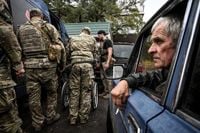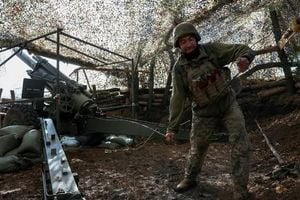On October 30, 2025, the Russian Defense Ministry made headlines by announcing its readiness to implement temporary ceasefires in three volatile regions of Ukraine—Pokrovsk, Dymytrov, and Kupiansk. The stated aim: to allow foreign journalists, including those from Ukraine, safe passage to encircled Ukrainian troops. The proposal, which would halt hostilities for five to six hours, comes directly on the heels of President Vladimir Putin’s directive to halt combat in these areas and grant media access. But as with so many developments in this long and bloody conflict, the offer has been met with deep skepticism, especially from Ukrainian officials and those who remember past tragedies.
According to the Russian Defense Ministry’s statement, commanders would establish secure corridors for journalists to enter and exit the conflict zones. These arrangements, however, would hinge on security guarantees for both the journalists and Russian military personnel. The ministry’s announcement, reported widely on Thursday, marks one of the more specific ceasefire proposals Moscow has floated for journalist access since the war’s escalation in 2022. Yet, questions remain: Can such guarantees be trusted? And what’s really motivating this sudden openness?
The timing of the offer is notable. Just weeks earlier, on October 13, a German media team from WELT came under attack by a Russian Lancet drone in Ukraine’s Dnipropetrovsk region. The team, which included producer Ivan Zakharenko, reporter Ibrahim Naber, and freelance camera operator Viktor Lysenko, was filming a report about a Ukrainian air defense unit less than 20 miles from the front. All three journalists wore clear press markings. The drone strike, which targeted a military vehicle, killed a Ukrainian soldier and severely wounded another. Zakharenko suffered two moderate shrapnel wounds in his legs, Naber was hit in the ear, and Lysenko suffered a concussion. As Zakharenko later wrote on Instagram, the attack left them shaken, underscoring the extraordinary risks journalists face in a war zone increasingly defined by drone warfare. According to the Committee to Protect Journalists (CPJ), at least 21 journalists and media workers have been killed since Russia’s full-scale invasion began in February 2022. October 2025 alone saw the deaths of French photojournalist Antoni Lallican and Ukrainian journalists Olena Hramova and Yevhen Karmazin in drone attacks.
The CPJ’s Europe and Central Asia program coordinator, Gulnoza Said, did not mince words: “The Russian attack on WELT journalists, which injured Ukrainian producer Ivan Zakharenko, is yet another illustration of the extraordinary risks journalists face while covering Russia’s war in Ukraine amid the widespread use of drones. Journalists are civilians under international humanitarian law and must be able to report safely on the war.” The Russian defense ministry, for its part, did not respond to CPJ’s request for comment.
Given this backdrop, Ukrainian officials have issued blunt warnings about the Russian ceasefire proposal. Georgiy Tikhiy, spokesperson for Ukraine’s Ministry of Foreign Affairs, took to the social network X to urge journalists not to trust President Putin’s promises regarding humanitarian corridors. “Honestly, I do not recommend that any journalist trust any of Putin’s proposals regarding ‘corridors’ in the zone of hostilities. I have seen with my own eyes how such proposals work – August 29, 2014, in Ilovaisk,” Tikhiy wrote, referencing a notorious incident during the earlier years of the conflict.
The Ilovaisk tragedy remains a searing memory for many Ukrainians. In August 2014, Ukrainian soldiers encircled in Ilovaisk were promised a “green corridor” to withdraw safely. Instead, as the columns moved along the agreed route, they came under devastating enemy fire, resulting in heavy casualties. Tikhiy’s message was clear: “Putin’s main aim is to continue the war and destabilize the situation on the front. He has never kept any of his promises to ceasefire. Do not help him justify his crimes through Russian provocations against journalists.”
Ukrainian authorities have gone further, warning that any visits to Russian-occupied territories without Kyiv’s permission violate both Ukrainian and international law, carrying serious reputational and legal consequences for journalists and media outlets. “We are closely monitoring the situation,” Tikhiy added, emphasizing the government’s vigilance.
There’s also a legal and ethical dimension to the dilemma. The Ukrainian government does not recognize the legitimacy of Russian-offered corridors and urges journalists to act with utmost caution to avoid falling victim to manipulation or worse. The Ministry of Foreign Affairs has called on all media institutions to cover events responsibly, prioritizing journalist safety and adhering to international law. The risk, officials say, is not just physical harm but also the possibility of being used in propaganda efforts that could distort the reality on the ground.
Meanwhile, the Russian side insists its intentions are humanitarian. The Defense Ministry has stated that the temporary ceasefire would allow journalists to “assess the situation firsthand and conduct interviews with the surrounded Ukrainian servicemen.” But Ukrainian Armed Forces Commander-in-Chief Oleksandr Syrskyi has flatly rejected Russian claims that Ukrainian troops are encircled near Pokrovsk and Kupiansk. “There is no blockade of Ukrainian soldiers,” Syrskyi said, noting that Russian forces are concentrating in urban areas but avoiding direct clashes. The implication: Russia’s narrative of encirclement is, at best, misleading.
This isn’t the first time Russia has offered ceasefires or corridors with strings attached, and the historical record—especially the events at Ilovaisk—has left Ukrainian officials and many in the international community wary. The memory of broken promises and deadly ambushes looms large. For journalists, the calculus is grim: The need to bear witness and report from the front lines is matched only by the peril that such access entails.
In the broader context, the war in Ukraine has become one of the most dangerous assignments for journalists anywhere in the world. Offices of media outlets have been shelled, homes of journalists targeted, and the use of advanced weaponry like drones has only increased the risks. The CPJ and other watchdog groups continue to call for accountability and protection for journalists, but the reality on the ground is fraught with danger and uncertainty.
As the dust settles on Russia’s latest ceasefire offer, the international media community faces difficult choices. The promise of access must be weighed against the hard lessons of history and the warnings of those who have seen the consequences firsthand. In the words of Ukraine’s foreign ministry spokesperson: “Do not help him justify his crimes through Russian provocations against journalists.” For now, the world watches and waits, hoping that the next story from the front won’t be another tragedy.




